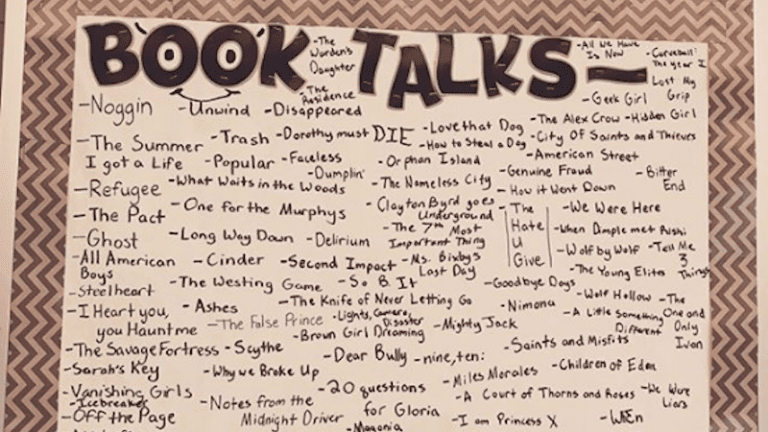Upper-elementary students are growing more opinionated by the minute. They might even be bold enough to challenge what you say at times. You can channel that independent thinking into your classroom book talks by giving your students some tools for analyzing, digesting and talking about what they’re reading.
As the texts your students are working with become more complex and cover a wider range of genres, these strategies will strengthen their critical-thinking skills and help them do well on that classroom-participation part of any rubric. Questions—your students’ questions about the text, their questions of one another as well as the questions you pose to them—are the basis for productive, inquiry-based conversations.
Below are eight tips for having engaging book talks with your students, accompanied by video clips showing how one class tackled a story about a girl whose father returns from serving overseas during World War II.
1. Leave them wondering.
Choose books with plots, dialogue and actions that can be interpreted in different ways. This leads to rich discussions with students as they debate a character’s motives or comments, or even the meaning of unfamiliar words. “We try to look for things that are weird and puzzling,” says Denise Ahlquist, vice president for professional learning at Great Books Foundation. “All of these are points of entry for kids.”
2.It’s story time.
It’s quite possible that your students are no longer being read to aloud at home. But that shouldn’t mean you stop reading to them in class, even if most of your students are independent readers by now. “It is meant to be a shared exploration,” Ahlquist says. Reading aloud—especially if this is the first time they’ve heard the story—allows you to model how the text should be read and the characters’ tone of voice. But don’t give away too much. Give your students some room to think, for example, about whether someone was angry, scared or being sarcastic.
3.Change it up.
Your students read the story or text a second time, but this can be done in a variety of ways, depending on their reading ability. Some of them might read it alone, some might read it with a partner or with a parent at home, and others might go to a listening center to hear an audio version. You can also play a recording for the whole class. “When you have a great, rich story, the second reading is not a chore,” Ahlquist says. “The texts are engaging and the prompts require you to make choices.” We all pick up more details when we watch a movie or read something a second time. Your students will too.
4. Take notes.
As you and your students do the first and second reading of the text, have them take notes regarding words or passages that leave them wondering. They can write down their questions on sticky notes to share with the class later. These questions will get your book discussion going when you get to that point.
5.Provide some clues.
You can guide your students’ questioning to some degree. For example, in the reading of Crow Call by Lois Lowry, the teacher asks students to jot down an N next to places in the story where they think the main character seems nervous and a C next to places where they think she is comfortable.
6.Make it personal.
It’s in your students’ questions that you will determine how to adapt their learning as they prepare to discuss the work with the class. “The questions are a window into their needs,” Ahlquist says. If they’re asking mostly about words they don’t understand, for instance, you can create some vocabulary activities for them. If they are wondering why the author wrote something a certain way, you might have a budding writer who wants to craft an alternative ending to the story. Ahlquist says instead of grouping students together based on their reading levels, she forms small groups based on aspects of the book that interest them, such as a time period or a particular character.
7.Let’s talk.
The readings and the note taking are preparing you and your students to talk about the text. You can pull from the students’ questions to get the discussion started, but you can also formulate a “focus question” to gather their varying interpretations of the same passage in the text.
8.Ask for proof.
Close reading is not only about reading texts more than once. It’s also about training students to always return to the book for evidence to support their response to the questions. This is where it gets interesting! As they discuss the text, students will share their thoughts and others will disagree and provide their own views or agree and add their own details from the text.
A few final thoughts:
First, if you are new to an inquiry-based model of teaching, don’t overwhelm yourself or your students by delving into a long book. Ahlquist recommends starting with a shorter text and spending only a day or two discussing key questions. As you and your students grow more comfortable with the process, the first and second readings, the discussions, and the students’ writing about the text can stretch over a week.
And second, these practices can be applied to just about anything your students are reading, whether it’s fiction, a historical document or an informational article on a new scientific discovery. Students can compare one text to another and think of questions about the perspective of the writers—is this a news article? Is it a persuasive piece? With inquiry-based teaching and learning, the possibilities are endless.



